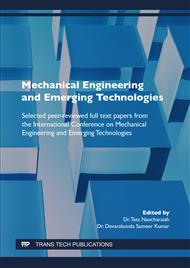[1]
H. Hocheng, H. Y. Tsai, J. J. Shiue, and B. Wang, Feasibility study of abrasive-waterjet milling of fiber-reinforced plastics,, J. Manuf. Sci. Eng. Trans. ASME, vol. 119, no. 2, p.133–142, (1997).
DOI: 10.1115/1.2831088
Google Scholar
[2]
J. Folkes, Waterjet-An innovative tool for manufacturing,, J. Mater. Process. Technol., vol. 209, no. 20, p.6181–6189, (2009).
DOI: 10.1016/j.jmatprotec.2009.05.025
Google Scholar
[3]
A. W. Momber, Principles of Abrasive Water Jet Machining. (2018).
Google Scholar
[4]
J. Wang and W. C. K. Wong, A study of abrasive waterjet cutting of metallic coated sheet steels,, Int. J. Mach. Tools Manuf., vol. 39, no. 6, p.855–870, (1999).
DOI: 10.1016/s0890-6955(98)00078-9
Google Scholar
[5]
M. Chithirai Pon Selvan, N. Mohana Sundara Raju, and H. K. Sachidananda, Effects of process parameters on surface roughness in abrasive waterjet cutting of aluminium,, Front. Mech. Eng., vol. 7, no. 4, p.439–444, (2012).
DOI: 10.1007/s11465-012-0337-0
Google Scholar
[6]
P. S. Chakravarthy and N. R. Babu, New approach for selection of optimal process parameters in Abrasive Water Jet cutting,, Mater. Manuf. Process., vol. 14, no. 4, p.581–600, (1999).
DOI: 10.1080/10426919908914851
Google Scholar
[7]
F. Müller and J. Monaghan, Non-conventional machining of particle reinforced metal matrix composite,, Int. J. Mach. Tools Manuf., vol. 40, no. 9, p.1351–1366, (2000).
DOI: 10.1016/s0890-6955(99)00121-2
Google Scholar
[8]
A. A. Khan and M. M. Haque, Performance of different abrasive materials during abrasive water jet machining of glass,, J. Mater. Process. Technol., vol. 191, no. 1–3, p.404–407, (2007).
DOI: 10.1016/j.jmatprotec.2007.03.071
Google Scholar
[9]
U. Çaydaş and A. Hasçalik, A study on surface roughness in abrasive waterjet machining process using artificial neural networks and regression analysis method,, J. Mater. Process. Technol., vol. 202, no. 1–3, p.574–582, (2008).
DOI: 10.1016/j.jmatprotec.2007.10.024
Google Scholar
[10]
M. A. Azmir and A. K. Ahsan, Investigation on glass/epoxy composite surfaces machined by abrasive water jet machining,, J. Mater. Process. Technol., vol. 198, no. 1–3, p.122–128, (2008).
DOI: 10.1016/j.jmatprotec.2007.07.014
Google Scholar
[11]
J. Wang and D. M. Guo, The cutting performance in multipass abrasive waterjet machining of industrial ceramics,, J. Mater. Process. Technol., vol. 133, no. 3, p.371–377, (2003).
DOI: 10.1016/s0924-0136(02)01125-1
Google Scholar
[12]
M. Chithirai, P. Selvan, N. Mohana, and S. Raju, Assessment of Process Parameters in Abrasive Waterjet Cutting of Stainless Steel,, Int. J. Adv. Eng. Technol., vol. 34, no. 3, p.34–40, (2011).
DOI: 10.1007/s11465-012-0337-0
Google Scholar
[13]
L. NAGDEVE, V. CHATURVEDI, and J. VIMAL, Implementation of Taguchi Approach for Ptimization of Abrasive Water Jet Machining Process Parameters,, Int. J. Instrum. Control Autom., p.224–228, (2012).
DOI: 10.47893/ijica.2012.1041
Google Scholar
[14]
A. A. P. U. D. Gulhane*, P. P. Patkar, P. P. Toraskar, S. P. Patil, ANALYSIS OF ABRASIVE JET MACHINING PARAMETERS ON MRR AND KERF WIDTH OF HARD AND BRITTLE MATERIALS LIKE CERAMIC,, nternational J. Des. Manuf. Technol. (IJDMT), ISSN 0976 – Int. J. Des. Manuf. 6995(Print), ISSN 0976 – 7002(Online) Vol. 4, Issue 1, Janu, vol. 4, no. 1, p.51–58, (2013).
DOI: 10.34218/ijdmt.4.1.2013.30320130401005
Google Scholar
[15]
S. Ekinović and ; S Yalcin, Application of Modelling and Optimization Methods in Abrasive Water Jet Machining,, J.Vivancos J. Trends Dev. Mach. Assoc. Technol., vol. 16, no. 1, p.59–62, (2012).
Google Scholar
[16]
J. Jeykrishnan, B. Vijaya Ramnath, S. Sree Vignesh, P. Sridharan, and B. Saravanan, Optimization of process parameters in abrasive water jet machining/cutting (AWJM) of nickel alloy using traditional analysis to minimize kerf taper angle,, Mater. Today Proc., vol. 16, p.392–397, (2019).
DOI: 10.1016/j.matpr.2019.05.106
Google Scholar
[17]
T. V. K. Gupta, J. Ramkumar, P. Tandon, and N. S. Vyas, Application of artificial neural networks in abrasive water jet milling,, Procedia CIRP, vol. 37, no. December, p.225–229, (2015).
DOI: 10.1016/j.procir.2015.08.076
Google Scholar
[18]
J. Viswanath, C. L. Tulasi, and K. Anand Babu, Optimizing the process parameters of AWJM using Taguchi method and ANOVA on Inconel 625,, ARPN J. Eng. Appl. Sci., vol. 13, no. 5, p.1578–1586, (2018).
Google Scholar
[19]
V. Chaturvedi and D. Singh, Multi response optimization of process parameters of abrasive water jet machining for stainless steel AISI 304 using VIKOR approach coupled with signal to noise ratio methodology,, J. Adv. Manuf. Syst., vol. 14, no. 2, p.107–121, (2015).
DOI: 10.1142/s0219686715500080
Google Scholar
[20]
R. M. Samson, S. Rajak, T. D. B. Kannan, and K. R. Sampreet, Optimization of Process Parameters in Abrasive Water Jet Machining of Inconel 718 Using VIKOR Method,, J. Inst. Eng. Ser. C, vol. 101, no. 3, p.579–585, (2020).
DOI: 10.1007/s40032-020-00569-4
Google Scholar
[21]
Jagadish, S. Bhowmik, and A. Ray, Prediction of surface roughness quality of green abrasive water jet machining: a soft computing approach,, J. Intell. Manuf., vol. 30, no. 8, p.2965–2979, (2019).
DOI: 10.1007/s10845-015-1169-7
Google Scholar
[22]
N. Yuvaraj and M. Pradeep Kumar, Multiresponse Optimization of Abrasive Water Jet Cutting Process Parameters Using TOPSIS Approach,, Mater. Manuf. Process., vol. 30, no. 7, p.882–889, (2015).
DOI: 10.1080/10426914.2014.994763
Google Scholar


